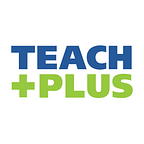Natalie Brown is a 15-year veteran educator in Texas who teaches 2nd grade math and science. She has held a distinguished teacher rating since the Teacher Excellence Initiative began in Dallas ISD in 2015. Natalie is a Teach Plus Texas Senior Policy Fellow.
A Day of COVID Teaching
Natalie currently teaches remotely from her classroom at Frank Guzick Elementary in Dallas. An average day for her starts around 7:15 a.m. in the classroom with at least two monitors to see all of her students as they rotate in 40-minute blocks in and out of their small groups and share the lesson. Natalie spends that time teaching, giving the students feedback, monitoring progress, and answering technology questions for the students and their families. Although she leaves campus in the afternoon to get home to her own kids, she usually keeps working until 8 p.m.
Self-care and setting boundaries around her days is hard. Her students’ parents frequently tell her to carve out more time for herself. “My [students’] parents have really been the ones who, if I’ll send a message at night, they’ll message me like, ‘Mrs. Brown, give yourself a break, send it out the next day,’” she said. She has two school-aged children; her husband is a small-business owner and is able to help them throughout the school day. Natalie has found that teaching and assisting her children simultaneously doesn’t work.
The Challenges
The majority of students at Frank Guzick Elementary are from lower socioeconomic backgrounds. Most of Natalie’s students did not have access to their own device and internet at home, so she has spent time teaching them and their families how to use the technology.
“It’s been eye-opening for me to see what an impact being able to have their own device and working internet has made in their life, and even their parents’ life,” she said. “I think trying to help both parents and students with technology and these new devices has been probably where I spend most of my time, but I know it’s going to pay off in the long run. It’s kind of like front-loading everything so that we can be successful down the road.”
Giving feedback is harder when classrooms are digital. “It’s much harder to explain what you’re trying to get them to fix or understand. On a piece of paper, it’s easier to call them over and show it to them,” she said. “Even just providing simple corrective feedback is one of the most challenging parts of a digital environment.”
The Solutions
Although giving feedback to her students has been tougher, teaching virtually and in small groups has allowed Natalie to differentiate the instruction and personalize it to each groups’ needs.
“I just feel like I’m able to meet the needs of my students better now that we’re teaching in small group rotations,” she said.
One of the most evident positive changes Natalie has seen is how much more involved her students’ families have been able to become.
“One positive thing was just the community and school partnership that’s really blossomed from this because I don’t think we (teachers and families) really realized how much we depended on each other until this happened,” she said. “It was just more of a transactional [relationship]. … But when everything switched, you really realized … that we really do depend on one another. So I talk to parents way more than I did before. I have so many more parents engaged in what their kids are learning every day and wanting to understand the process.”
From COVID Solutions to Systemic Changes
Natalie wants to take aspects of remote learning with her when things go back to being fully in person.
“What I think is really cool is my ability to flip curriculum,” she said. “Some of the skills that we would normally do in class can now be flipped at home, and we can spend more time in class teaching them things they need to be better readers or understand the math concepts more.”
“I think that will change homework too. I think a lot of the things that we would have them do independently at home and expect them to bring back, we can work on those skills in class and they do the other things at home.”
Being in a school building exclusively with adults day in and day out and teaching to an empty classroom is a strange feeling for Brown, but it reminds her what’s important and why she teaches.
“Fifteen years in, sometimes we lose sight of that, or it’s just like another year, but then when things change, I think it just really puts things in perspective,” Natalie said. “I’m ready for kids to come back. I’m ready to have that interaction with kids again, as long as it’s safe.”
Kathy Pierre is Senior National Coordinator of Communications and Media at Teach Plus.
